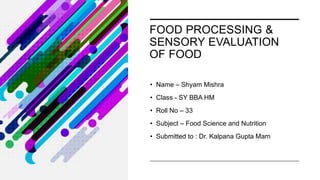
Food processing and sensory evaluation of food
- 1. FOOD PROCESSING & SENSORY EVALUATION OF FOOD • Name – Shyam Mishra • Class - SY BBA HM • Roll No – 33 • Subject – Food Science and Nutrition • Submitted to : Dr. Kalpana Gupta Mam
- 2. FOOD PROCESSING • Food processing is the transformation of agricultural products into food, or of one form of food into other forms. Food processing includes many forms of processing foods, from grinding grain to make raw flour to home cooking to complex industrial methods used to make convenience foods. Some food processing methods play important roles in reducing food waste and improving food preservation, thus reducing the total environmental impact of agriculture and improving food security. • Primary food processing is necessary to make most foods edible, and secondary food processing turns the ingredients into familiar foods, such as bread. Tertiary food processing has been criticized for promoting overnutrition and obesity, containing too much sugar and salt, too little fiber, and otherwise being unhealthful in respect to dietary needs of humans and farm animals. This Photo by Unknown author is licensed under CC BY.
- 3. PROCESS • Primary food processing • These whole, dried bananas in Thailand are an example of primary food processing. • Primary food processing turns agricultural products, such as raw wheat kernels or livestock, into something that can eventually be eaten. This category includes ingredients that are produced by ancient processes such as drying, threshing, winnowing and milling grain, shelling nuts, and butchering animals for meat. It also includes deboning and cutting meat, freezing and smoking fish and meat, extracting and filtering oils, canning food, preserving food through food irradiation, and candling eggs, as well as homogenizing and pasteurizing milk.
- 4. PROCESS • Secondary food processing • Baking bread is an example of secondary food processing. • Secondary food processing is the everyday process of creating food from ingredients that are ready to use. Baking bread, regardless of whether it is made at home, in a small bakery, or in a large factory, is an example of secondary food processing. Fermenting fish and making wine, beer, and other alcoholic products are traditional forms of secondary food processing. Sausages are a common form of secondary processed meat, formed by comminution (grinding) of meat that has already undergone primary processing. Most of the secondary food processing methods known to human kind are commonly described as cooking methods. • Tertiary food processing • Tertiary food processing is the commercial production of what is commonly called processed food. These are ready-to-eat or heat-and-serve foods, such as TV dinners and re-heated airline meals.
- 5. BENEFITS Benefits of food processing include toxin removal, preservation, easing marketing and distribution tasks, and increasing food consistency. In addition, it increases yearly availability of many foods, enables transportation of delicate perishable foods across long distances and makes many kinds of foods safe to eat by de-activating spoilage and pathogenic micro-organisms. Modern supermarkets would not exist without modern food processing techniques, and long voyages would not be possible. Processed foods are usually less susceptible to early spoilage than fresh foods and are better suited for long-distance transportation from the source to the consumer. When they were first introduced, some processed foods helped to alleviate food shortages and improved the overall nutrition of populations as it made many new foods available to the masses. Processing can also reduce the incidence of food-borne disease. Fresh materials, such as fresh produce and raw meats, are more likely to harbour pathogenic micro-organisms (e.g. Salmonella) capable of causing serious illnesses. The extremely varied modern diet is only truly possible on a wide scale because of food processing. Transportation of more exotic foods, as well as the elimination of much hard labor gives the modern eater easy access to a wide variety of food unimaginable to their ancestors.
- 6. DRAWBACKS Meat packages in a Roman supermarket Processing of food can decrease its nutritional density. The amount of nutrients lost depends on the food and processing method. For example, heat destroys vitamin C. Therefore, canned fruits possess less vitamin C than their fresh alternatives. The USDA conducted a study of nutrient retention in 2004, creating a table of foods, levels of preparation, and nutrition. New research highlighting the importance to human health of a rich microbial environment in the intestine indicates that abundant food processing (not fermentation of foods) endangers that environment. Using some food additives represents another safety concern. The health risks of any given additive vary greatly from person to person; for example using sugar as an additive endangers diabetics. In the European Union, only European Food Safety Authority (EFSA) approved food additives (e.g., sweeteners, preservatives, stabilizers) are permitted at specified levels for use in food products. Approved additives receive an E number (E for Europe), simplifying communication about food additives included in the ingredients' list for all the different languages spoken in the EU. As effects of chemical additives are learned, changes to laws and regulatory practices are made to make such processed foods more safe.
- 7. WHAT IS FOOD SENSORY EVALUATION ? • Sensory assessment is a scientific field covering all techniques for eliciting, measuring, analyzing, and interpreting human reactions to food characteristics perceived by the five senses: taste, smell, touch, sight, and hearing. Taste and smell are two senses that have piqued researchers’ curiosity, particularly related to ingestive behaviour.
- 8. WHY IS SENSORY EVALUATION IN THE FOOD INDUSTRY IMPORTANT? • Sensory assessment is a necessary method in the following five categories of problems: • Development of new products • Cost-cutting measures • Increasing the level of quality • Product acceptability • Quality assurance and control
- 9. THANK YOU